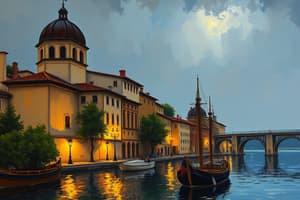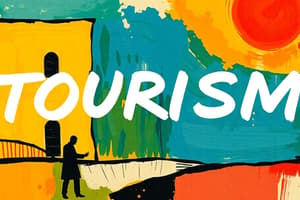Podcast
Questions and Answers
A ______ is defined as an entity, such as a person, organization, or community, with responsibilities to ensure the success and sustainability of a heritage site or attraction.
A ______ is defined as an entity, such as a person, organization, or community, with responsibilities to ensure the success and sustainability of a heritage site or attraction.
stakeholder
______ are responsible for immigration regulatory and control within the Philippines.
______ are responsible for immigration regulatory and control within the Philippines.
Bureau of Immigration
The ______ is tasked with maintaining peace and order in the Philippines.
The ______ is tasked with maintaining peace and order in the Philippines.
Philippine National Police
The ______ operates under R.A. 5173, enforcing laws upon the high seas and waters.
The ______ operates under R.A. 5173, enforcing laws upon the high seas and waters.
A ______ or visitor may be either local or foreign individuals seeking to view or experience a heritage tourism product.
A ______ or visitor may be either local or foreign individuals seeking to view or experience a heritage tourism product.
______ refers to villages, barangays, municipalities, cities, provinces, or regions that are the location of heritage sites.
______ refers to villages, barangays, municipalities, cities, provinces, or regions that are the location of heritage sites.
______ refers to non-governmental organizations, advocacy groups, and media involved in heritage tourism.
______ refers to non-governmental organizations, advocacy groups, and media involved in heritage tourism.
______ are entities like tour operators, travel agencies, event promoters, and tour guides that facilitate tourist experiences.
______ are entities like tour operators, travel agencies, event promoters, and tour guides that facilitate tourist experiences.
______ include individuals and organizations that ensure the satisfaction of cultural tourists.
______ include individuals and organizations that ensure the satisfaction of cultural tourists.
The ______ manages government-owned tourism-oriented establishments, usually located in tourist destinations, under R.A. 9593.
The ______ manages government-owned tourism-oriented establishments, usually located in tourist destinations, under R.A. 9593.
The ______ is responsible for land access to heritage sites and attractions.
The ______ is responsible for land access to heritage sites and attractions.
Under R.A. 6795, the ______ supervises all the local government units.
Under R.A. 6795, the ______ supervises all the local government units.
______ preserves and enhances the historical value of Intramuros.
______ preserves and enhances the historical value of Intramuros.
The ______ is tasked to develop and preserve the Quezon Memorial Park and Rizal Park.
The ______ is tasked to develop and preserve the Quezon Memorial Park and Rizal Park.
The ______, formerly known as the Philippine Convention and Visitors Corporation, serves as the marketing arm of the Department of Tourism under R.A. 9593.
The ______, formerly known as the Philippine Convention and Visitors Corporation, serves as the marketing arm of the Department of Tourism under R.A. 9593.
The ______, under Executive Order 192, is the government agency responsible for environmental and natural resources.
The ______, under Executive Order 192, is the government agency responsible for environmental and natural resources.
Under Executive Order 133, the ______ serves as the primary coordinative, promotive, and facilitative arm for trade for small and micro enterprises (SMEs) in host communities of heritage.
Under Executive Order 133, the ______ serves as the primary coordinative, promotive, and facilitative arm for trade for small and micro enterprises (SMEs) in host communities of heritage.
The ______ collects lawful revenues and prevents smuggling and other frauds under R.A. 1937.
The ______ collects lawful revenues and prevents smuggling and other frauds under R.A. 1937.
______ has been launched and is deemed ready to be introduced to the market.
______ has been launched and is deemed ready to be introduced to the market.
______ reach their peak sometime after 10-20 years of constant exposure and visits.
______ reach their peak sometime after 10-20 years of constant exposure and visits.
Flashcards
Stakeholder (Heritage Tourism)
Stakeholder (Heritage Tourism)
An entity (person, organization, or community) with responsibilities to ensure the success and sustainability of a heritage site or attraction.
Tourists or Visitors
Tourists or Visitors
Local or foreign individuals who seek to view or experience a heritage tourism product.
Department of Tourism
Department of Tourism
Charge overall of all tourism sites, attractions
National Historical Institute
National Historical Institute
Signup and view all the flashcards
National Commission for Culture
National Commission for Culture
Signup and view all the flashcards
Tourism Infrastructure and Enterprise Zone Authority
Tourism Infrastructure and Enterprise Zone Authority
Signup and view all the flashcards
Department of Interior and Local Government
Department of Interior and Local Government
Signup and view all the flashcards
Intramuros Administration
Intramuros Administration
Signup and view all the flashcards
National Parks and Development Committee
National Parks and Development Committee
Signup and view all the flashcards
Tourism Promotions Board
Tourism Promotions Board
Signup and view all the flashcards
Department of Trade and Industry
Department of Trade and Industry
Signup and view all the flashcards
Bureau of Immigration
Bureau of Immigration
Signup and view all the flashcards
National Museum
National Museum
Signup and view all the flashcards
Suppliers and Service Providers
Suppliers and Service Providers
Signup and view all the flashcards
Host Communities
Host Communities
Signup and view all the flashcards
NGOs and Public Interest Groups
NGOs and Public Interest Groups
Signup and view all the flashcards
Intermediaries
Intermediaries
Signup and view all the flashcards
Culture Life Cycle: Early Development
Culture Life Cycle: Early Development
Signup and view all the flashcards
Culture Life Cycle: Launch
Culture Life Cycle: Launch
Signup and view all the flashcards
Culture Life Cycle: Growth
Culture Life Cycle: Growth
Signup and view all the flashcards
Study Notes
- Stakeholders in heritage tourism include entities like people, organizations or communities
- Stakeholders ensure the success and sustainability of a heritage site or attraction
- Heritage sites or attractions are owned and managed to organize heritage tourism products, such as Rizal Tubbataha Reefs
- Tourists or visitors, whether local or foreign, seek to view or experience a heritage tourism product.
Government Agencies
- The Department of Tourism oversees all tourism sites and attractions
- The National Historical Institute focuses on preservation, restoration, and reconstruction of churches and monuments
- The National Commission for Culture develops policies for culture and the arts and preserves Filipino cultural heritage
- Tourism Infrastructure and Enterprise Zone Authority (TIEZA), under RA 9593, manages government-owned tourism establishments
- The Department of Public Works and Highways provides land access to heritage sites and attractions
- The Department of Interior and Local Government (DILG), under RA 6795, supervises local government units
- The Intramuros Administration preserves and enhances the historical value of Intramuros
- The National Parks and Development Committee develops and preserves Quezon Memorial Park and Rizal Park
- Tourism Promotions Board, under RA 9593, is the marketing arm of the Department of Tourism
- The Department of Environment and Natural Resources (DENR), under Executive Order 192, is responsible for environmental concerns
- The Department of Trade and Industry (DTI), under Executive Order 133, promotes trade and supports small businesses in heritage sites
- The Bureau of Food and Drug Administration handles manufacturing, packaging, and importation
- The Philippine Retirement Authority (PRA), under F.O. 1037, addresses issues about retirees
- The Bureau of Customs, under RA 1937, collects revenues and prevents smuggling
- The Bureau of Immigration regulates immigration
- The Philippine National Police maintains peace and order
- The Philippine Coast Guard, under RA 5173, enforces laws on the seas
- The National Museum acquires, documents, preserves, and exhibits cultural items
- The National Commission on Indigenous Peoples (NCIP) protects the rights of indigenous peoples
Other Stakeholders
- Host communities include villages, municipalities, cities, provinces, or regions
- NGOs and Public Interest Groups encompass non-governmental organizations, advocacy groups and the media
- Intermediaries include tour operators, travel agencies, promoters, and tour guides
- Suppliers and Service Providers ensure the satisfaction of cultural tourists
Culture Life Cycle
- Early development or conceptualization starts with brainstorming
- Launch, inauguration, or commencement introduces the product to the market
- Growth involves marketing and promotion
- Maturity is reached after 10-20 years of exposure
- Tourism Innovation occurs at maturity, with funding from government, the private sector, or NGOs
- Decline occurs when the product loses appeal, with fewer visitors and lower revenues.
Studying That Suits You
Use AI to generate personalized quizzes and flashcards to suit your learning preferences.




